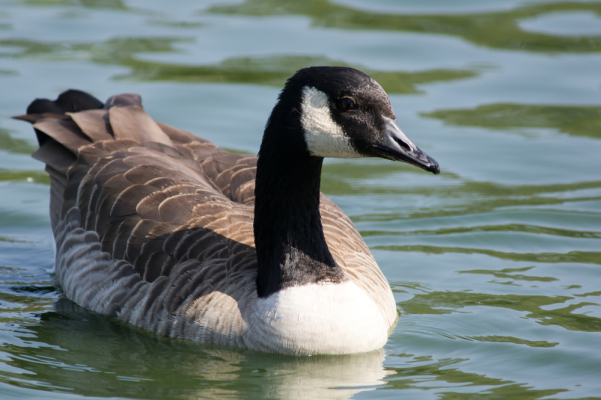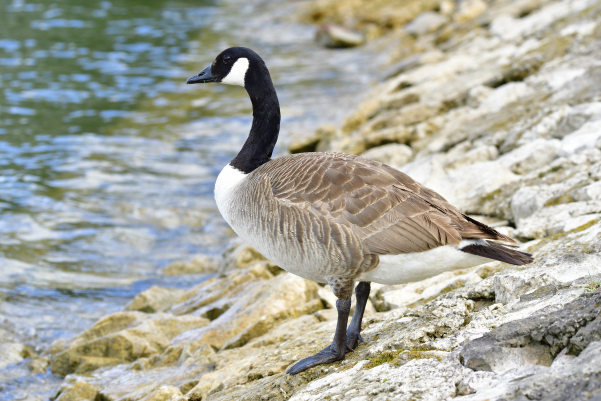
The Canada Goose(Branta canadensis) is the largest goose in the world, and it is well known for its distinctive flying formation. When you look up at the sky, you will instantly know that a flock of Canada geese is flying because of its V-formation flying pattern. While the Canada Goose may look small and reach an average of about 14 pounds(6.35 kilograms), they have a wingspan of up to 6 feet(1.83 meters). As a result, the Canada Goose has become an iconic bird throughout the world and especially in Canada. To find out more about the Canada Goose, continue on reading.

Their Looks
Males and females look the same in terms of their plumage. Their head and necks are both black with a noticeable white cheek patch.
They all mostly have a greyish brown body with white feathers under their tail.
Canada Geese are known for their extremely loud honks when flying.
Where Do They Live?
You can find Canada Geese in many places in North America. They are drawn to all kinds of water found across the continent, stretching from the tundra to the Gulf Coast.
So, if you want to try and spot a Canada Goose, your best bet is checking out ponds, lakes, rivers, freshwater and saltwater marshes. However, they have also been seen infiltrating the urban areas and agricultural areas.
In terms of the nest, the nest of a Canada Goose is large and has a mound of vegetation such as cattail stems and grass. You will almost always find a nest if there is water nearby. The males will stand guard over the nest while the females will lay about 2-8 eggs in the nest. The eggs are incubated for about 25 days.
Their Diet
The diet of a Canada Goose is mainly aquatic plants, grass, grains, and some small aquatic animals.
Migrating
When you look up at the sky and see the classic V-formation of the Canada Goose, that will tell you that they are migrating into somewhere warmer and where there is more food.
When the Canada Goose migrates, they will usually follow the same path every year. Some of the common paths or routes they take are the Atlantic flyway along the east coast of North America. The Mississippi flyway, the central flyway, which is along the Rocky Mountains, and the Pacific flyaway, west of the Rockies.
If you’re ever curious about why they fly in a V-formation, many scientists think it’s due to the drafting effect. Whereby flying in this manner will conserve the bird’s energy when they fly very long distances.
You will always see the leader in the front, but their job is to split the air current; while this takes a lot of energy, the leader will generally fall back, and a new bird will assume the role of the leader.
Some interesting facts that are worth mentioning about the Canada Goose include:
They Are Quick Learners
Canada Geese are brilliant birds. The baby geese which are also called goslings are known to follow anything that moves.
Whether it be dogs, people, or cats, they will mistake these creatures for their mother. While some other animals may take some time to learn how to swim, a gosling can dive 30 feet underwater at only one day old.
The parents teach their young how to fly in their first three months of life. The goslings will be with their parents for the following year. So, this means that they will migrate with them to another region.
Mates for Life
Canada Geese will not look for a potential mate until they’re about three years old. However, once they do reach mating age, they start using assortative mating.
This means that they will look for other Canada Geese that are about the same size as themselves. When they find that special someone, they will mate for life with that bird.
The average life span is about 10 to 25 years, but if the partner dies, then the other goose will try to find a new mate.
They Almost Became Extinct
Back in the early 1900s, Canada Geese were almost completely wiped out. When people began to find out, some programs started to help them.
One program even rounded up as many Canada Geese they could, and they put a band around their leg. This helped the researchers learn more about the bird’s migration patterns and their life span.
Due to this, the bird was protected, and they continued to thrive.
They Travel A lot!
Because Canada Geese need a lot of open water to feed, lay their eggs, and swim, they cannot survive if the water is frozen. So, if the water is frozen or there’s no more food, then the Canada Geese will pack their bags up and migrate.
They will then return to their birthplace in spring. They can also travel up to 1,500 miles in one day if the weather favors them, and they can also fly about 40 miles in one hour during migration season.
Canada Geese tend to travel in a large flock of about 30 to 100 birds.
They Will Attack
If a Canada Goose feels threatened, or if it is feels its goslings are in danger, they have no trouble stepping up and protecting their goslings.
They will stretch out their neck and wings while producing a hissing sound and honking very loudly.
